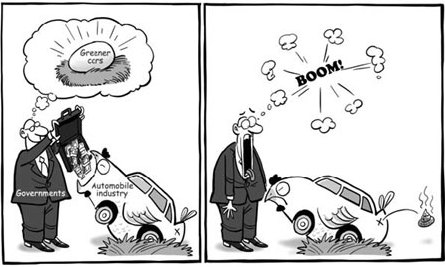Car makers' green subsidy just a bail-out
While all eyes were fixed on the banking bail-out, a bucketload of public money was quietly sloshed into the pockets of another undeserving cause. Recently George W. Bush agreed to lend $25 billion to US car manufacturers.
It has already crossed the Atlantic, and European car makers have demanded that the EU hand them 40 billion euros in cheap loans to match the US subsidy. Where will the public spending spree end?
The motor companies in both Europe and the US claim they need these loans to help them go green. They will invest the money in a new generation of environmental technologies, which will allow them to meet the efficiency standards their governments are setting.
There is more joy in heaven over one sinner who repents ... but how strange this green enthusiasm seems, now that there's the smell of public money in the air. For the past ten years the car manufacturers have driven every useful green initiative into the wall.
In 1998 European car makers promised to show that they could cut their greenhouse gases voluntarily. By the end of 2008, they pledged, they would reduce the average emissions produced by their cars from 190 g of carbon dioxide per km to 140. How well have they done? By the end of last year they had cut average pollution to 158 g/km across Europe and 165 g/km in the UK: they will miss their target by some 40 percent.

Discerning, only ten years too late, that lobby groups' promises are worth as much as a share in Lehman Brothers, in 2006 the European commission announced that it would set compulsory standards: by 2012 all manufacturers would have to reduce their average CO2 emissions to 120 g/km. It looked like progress, until you remembered that 120 g was the target proposed by the EU in 1994, to be met by 2005. It was repeatedly delayed by industry lobbying.
Last year the 2012 target fell to the same forces. Angela Merkel, lobbying on behalf of companies such as DaimlerChrysler and BMW, demanded that the European commission put the brakes on. The commission agreed to revise the figure to 130 g, and to cover the gap by raising the contribution from biofuels.
Now the pollutocrats are whingeing that they cannot meet the 130 g target either. A month ago they persuaded the European parliament's industry committee to take up their case: it proposed postponing the target until 2015, reducing the fines if they don't comply, and allowing manufacturers to offset eco-innovations against the target even if these don't actually reduce emissions. These invertebrates, in other words, proposed to grant official approval to industry greenwash.
In the US, manufacturers have still not reached the standard that they were supposed to have met, under the Energy Policy Conservation Act, by 1985.
What makes this dithering so frustrating is that to be talking, in 2008, about targets of 130 or 120 g/km is a bit like discussing whether modern computers should have 10 rows of sliding beads or 100.
Nor is there a good commercial reason. A poll by the Newspaper Marketing Agency shows that 80 percent of car buyers say economy is now more important to them than performance. The car industry's technological failure results entirely from lobbying by the companies now demanding public money to go green. They want to squeeze every last drop from existing technologies before switching to better models.
Their sabotage of green technology has been both subtle and comprehensive. The film Who Killed The Electric Car? shows how the manufacturers, working with oil companies and corrupt officials, sank California's attempt to change vehicle technologies. Having bumped off battery power, they persuaded the federal government to pour money instead into hydrogen vehicles, aware that the technological hurdles are so high that a cheap, mass-produced model might never be possible.
Electric cars, by contrast, have been ready for the mass market for almost a century. The $1.2 billion that the US government is spending on research and development for hydrogen cars - like the 2 billion euros pledged to the same quest by the European Union - is a subsidy for avoiding technological change.
There is no need to spend a penny of public money on greening the motor industry. As a recent report by the British House of Commons environmental audit committee shows, you could achieve the same outcome by creating a bigger differential between vehicle tax bands: it proposes that people buying the least efficient cars should pay around 2,000 more pounds per year than those buying the most efficient. This would kill the market for gas guzzlers and force the industry to make the changes it has long resisted.
But the government has taken all the flak a good tax policy would have generated for very little gain. Subsidies are what governments pay when regulation doesn't happen. If you don't have the guts to force companies to do something, you must bribe them instead. It's a fair guess that European car makers will still fail to meet their environmental targets, even if they get the money they are demanding. The greenest thing governments could do is to allow these foot-dragging, planet-eating spongers to go under.
The Guardian
(China Daily 10/14/2008 page9)














